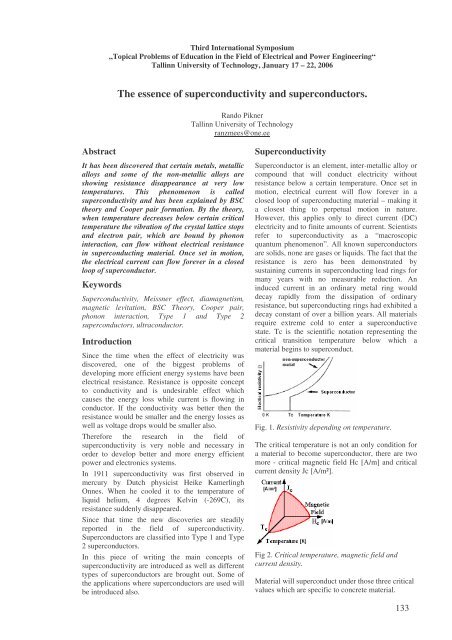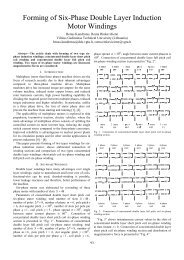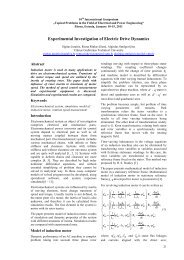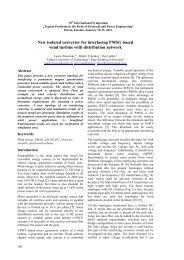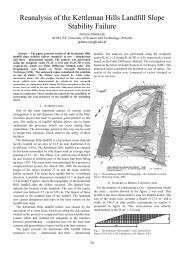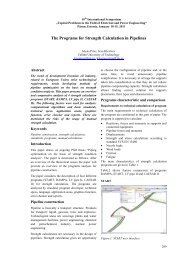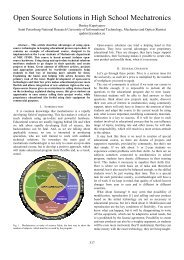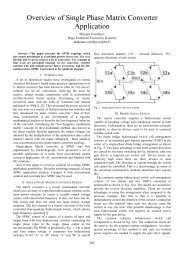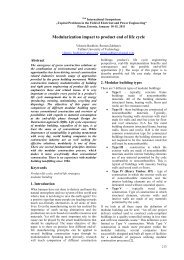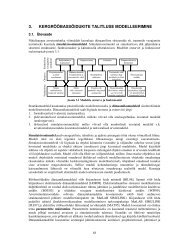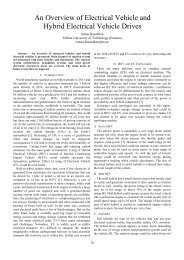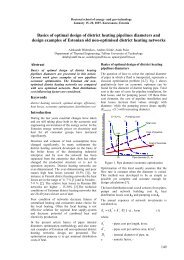The essence of superconductivity and superconductors.
The essence of superconductivity and superconductors.
The essence of superconductivity and superconductors.
Create successful ePaper yourself
Turn your PDF publications into a flip-book with our unique Google optimized e-Paper software.
Electrons in crystal lattice <strong>of</strong> conductorIn metals such as copper <strong>and</strong> aluminium, electricityis conducted as outer energy level valence electronsmigrate as individuals from one atom to another,forming electrical current. <strong>The</strong>se atoms form avibrating lattice, the warmer the metal the more itvibrates. As the electrons begin moving through thelattice structure, they collide with tiny impurities orimperfections in the lattice. When the electronsbump into these obstacles they fly <strong>of</strong>f in alldirections <strong>and</strong> lose energy in the form <strong>of</strong> heat.Fig 3. Atoms arranged in a crystalline lattice <strong>and</strong>moving electrons bouncing <strong>of</strong>f the atoms that are intheir way.<strong>The</strong> ability <strong>of</strong> electrons to pass throughsuperconducting material unobstructed has puzzledscientists for many years. <strong>The</strong> warmer a substance isthe more it vibrates. Conversely, the colder asubstance is the less it vibrates. Early researcherssuggested that fewer atomic vibrations would permitelectrons to pass more easily. However this predictsa slow decrease <strong>of</strong> resistivity with temperature. Itsoon became apparent that these simple ideas couldnot explain <strong>superconductivity</strong>. It is much morecomplicated than that.Cooper Pairs <strong>and</strong> electron-phononinteractionMathematically complex BCS theory relies on anearlier discovery by Cooper (1956), who showed thatin extreme temperatures the electrons are formingthe pairs <strong>of</strong> two - these pairs are known as Cooperpairs.Cooper managed to found as answer to the questionwhy electrons, which normally repel one another,must feel an overwhelming attraction in<strong>superconductors</strong>. <strong>The</strong> answer to this problem wasfound to be in phonons, packets <strong>of</strong> sound wavespresent in the lattice as it vibrates. Although thislattice vibration cannot be heard, its role as amoderator is indispensable.Fig. 4. Phonon interaction between electrons <strong>of</strong> theCooper pair.Figure 4 shows that electron pairs are coupling overa range <strong>of</strong> hundreds <strong>of</strong> nanometers, three orders <strong>of</strong>magnitude larger than the lattice spacing. <strong>The</strong>secoupled electrons can take the character <strong>of</strong> a boson<strong>and</strong> condense into the ground state.Normally the electrons are fermions which areparticles with half-integer spin. <strong>The</strong> fact thatelectrons are fermions is foundational to the buildup<strong>of</strong> the periodic table.<strong>The</strong> fermions obey the “Pauliexclusion principle” which states that two fermionscannot have the same quantum state <strong>and</strong> the samespin.<strong>The</strong> bosons, however, are particles which haveinteger spin <strong>and</strong> therefore are not constrained by thePauli exclusion principle. <strong>The</strong> energy distribution <strong>of</strong>bosons is described by Bose-Einstein statistics. Atlow temperatures, bosons can behave verydifferently than fermions because an unlimitednumber <strong>of</strong> them can collect into the same energystate. <strong>The</strong> collection into a single state is calledcondensation, or Bose-Einstein condensation. <strong>The</strong>boson-like behavior <strong>of</strong> such electron pairs wasfurther investigated by Cooper <strong>and</strong> they are called"Cooper pairs". <strong>The</strong> condensation <strong>of</strong> Cooper pairs isthe foundation <strong>of</strong> the BCS <strong>The</strong>ory <strong>of</strong><strong>superconductivity</strong>.BCS <strong>The</strong>ory<strong>The</strong> BCS theory explains <strong>superconductivity</strong> attemperatures close to absolute zero. According to thetheory, as one negatively charged electron passes bypositively charged ions (cations) in the lattice <strong>of</strong> thesuperconductor, the lattice distorts inwards. This inturn causes phonons to be emitted, which forms adensity <strong>of</strong> positive charges around the electron.Figure 5 illustrates a wave <strong>of</strong> lattice distortion due toattraction to a moving electron.Fig. 5. Electron moving in superconducting metalcausing the atoms to distort towards negativecharge.As negatively charged electron passes betweenmetal’s positively charged atoms in the lattice, theatoms are attracted inwards. <strong>The</strong> distortion <strong>of</strong> thelattice creates a region <strong>of</strong> enhanced positive charge<strong>and</strong> another electron at some distance in the lattice isthen attracted to this charge distortion - the electronphononinteraction. <strong>The</strong> electrons are thus indirectlyattracted to each other <strong>and</strong> form a Cooper pair - anattraction between two electrons mediated by thelattice which creates a 'bound'state <strong>of</strong> the twoelectrons.<strong>The</strong> forces exerted by the phonons overcome theelectrons natural repulsion. <strong>The</strong> electron pairs are134
coherent with one another as they pass through theconductor in unison. <strong>The</strong> electrons are screened bythe phonons <strong>and</strong> are separated by some distance.When one <strong>of</strong> the electrons that make up a Cooperpair <strong>and</strong> passes close to an ion in the crystal lattice,the attraction between the negative electron <strong>and</strong> thepositive ion cause a vibration to pass from ion to ionuntil the other electron <strong>of</strong> the pair absorbs thevibration. <strong>The</strong> net effect is that the electron hasemitted a phonon <strong>and</strong> the other electron has absorbedthe phonon. It is this exchange that keeps the Cooperpairs together. It is important to underst<strong>and</strong>,however, that the pairs are constantly breaking <strong>and</strong>reforming. Because electrons are indistinguishableparticles, it is easier to think <strong>of</strong> them as permanentlypaired.<strong>The</strong> identifying characteristics <strong>of</strong> Type 1<strong>superconductors</strong> are very sharp transition tosuperconducting state <strong>and</strong> perfect diamagnetism. <strong>The</strong>applied magnetic field induces eddy-currents on thesurface <strong>of</strong> the superconductor which then generatethe opposite magnetic field <strong>and</strong> repels the appliedmagnetic field as described in figure 7.Fig. 7. Induced magnetic field repels completely theapplied field.Figure 7 shows that when an external magnetic field(horizontal abscissa) is applied to a Type Isuperconductor the induced magnetic field (verticalordinate) exactly cancels that applied field until thereis an abrupt change from the superconducting stateto the normal state.Fig. 6. <strong>The</strong> electron is attracted to the positivecharge density (red glow) created by the firstelectron distorting the lattice around itself, formingthe Cooper pair.<strong>The</strong> Cooper pairs within the superconductor are whatcarry the supercurrent, but why do they experiencesuch perfect conductivity? Mathematically, becausethe Cooper pair is more stable than a single electronwithin the lattice, it experiences less resistance.Physically, the Cooper pair is more resistant tovibrations within the lattice as the attraction to itspartner will keep it 'on course'- therefore, Cooperpairs move through the lattice relatively unaffectedby thermal vibrations (electron-phonon interactions)below the critical temperature.Type 1 <strong>superconductors</strong><strong>The</strong> Type 1 category <strong>superconductors</strong> are mainlymetals <strong>and</strong> metalloids that show some conductivityat room temperature. <strong>The</strong> thirty pure metals are type1 <strong>superconductors</strong>. <strong>The</strong>y require incredible cold toslow down molecular vibrations sufficiently t<strong>of</strong>acilitate unimpeded electron flow in accordancewith what is known as BCS theory. Remarkably, thebest conductors at room temperature (gold, silver,<strong>and</strong> copper) do not become superconducting at all.<strong>The</strong>y have the smallest lattice vibrations, so theirbehavior correlates well with the BCS <strong>The</strong>ory.While instructive for underst<strong>and</strong>ing <strong>superconductivity</strong>,the Type I <strong>superconductors</strong> have been<strong>of</strong> limited practical usefulness because the criticalmagnetic fields are so small <strong>and</strong> the superconductingstate will appear at extreme temperature <strong>of</strong> liquidHelium. Type I <strong>superconductors</strong> are sometimescalled "s<strong>of</strong>t" <strong>superconductors</strong>.Fig. 8. Superconductor compared with ordibaryconductor in magnetic field.This phenomenon is called Meissner effect (Fig. 8.)<strong>and</strong> can be easily demonstrated in a form <strong>of</strong>magnetic levitation. If a small magnet is broughtnear a superconductor, it will be repelled becausedinduced supercurrents will produce mirror images <strong>of</strong>each pole. If a small permanent magnet is placedabove a superconductor, it can be levitated by thisrepulsive force, see figure 9.Fig. 9. Permanent magnet is levitating over thesuperconductor.135
Many additional elements can be coaxed into asuperconductive state with the application <strong>of</strong> highpressure. For example, phosphorus appears to be theType 1 element with the highest Tc. But, it requirescompression pressures <strong>of</strong> 2.5 Mbar to reach a Tc <strong>of</strong>22 K (-251ºC).Type I <strong>superconductors</strong> are very pure metals thattypically have critical fields too low for use insuperconducting magnets.Type 2 <strong>superconductors</strong>Superconductors made from metallic compounds<strong>and</strong> alloys are called Type 2 <strong>superconductors</strong>. <strong>The</strong>recently-discovered superconducting "perovskites"(metal-oxide ceramics that normally have a ratio <strong>of</strong> 2metal atoms to every 3 oxygen atoms) belong to thisType 2 group. Besides being mechanically harderthan Type 1 <strong>superconductors</strong>, they exhibit muchhigher critical magnetic fields <strong>and</strong> higher Tc's thanType 1 <strong>superconductors</strong> by a mechanism that is stillnot completely understood.Type 2 <strong>superconductors</strong> - also known as the "hard"or high temperature <strong>superconductors</strong> - differ fromType 1 in that their transition from a normal to asuperconducting state is gradual across a region <strong>of</strong>"mixed state" behavior. Since a Type 2 will allowsome penetration by an external magnetic field intoits surface, this creates some rather novelmacroscopic phenomena where superconductorusually exist in a mixed state <strong>of</strong> normal <strong>and</strong>superconducting regions.Fig. 10. Mixed state <strong>of</strong> type 2 superconductor.This is sometimes called a vortex state, becausevortices <strong>of</strong> superconducting currents surround cores<strong>of</strong> normal material. As their critical temperatures areapproached, the normal cores are more closelypacked <strong>and</strong> eventually overlap as thesuperconducting state is lost. A size <strong>of</strong> about 300 nmis typical for the normal cores. While the Meissnereffect is modified to allow magnetic fields throughthe normal cores, magnetic fields are still excludedfrom the superconducting regions.<strong>The</strong> superconducting cuprates (copper-oxides) haveachieved astonishingly high Tc's when consideredthat by 1985 known Tc's had only reached 23 K forType 1. To date, the highest Tc attained at ambientpressure has been 138 K (-135ºC) <strong>and</strong> is held by athallium-doped, mercuric-cuprate comprised <strong>of</strong> theelements Mercury, Thallium, Barium, Calcium,Copper <strong>and</strong> Oxygen.One theory predicts an upper limit <strong>of</strong> about 200 Kfor the layered cuprates (Vladimir Kresin, Phys.1997). Others assert there is no limit. Either way, itis almost certain that other, more-synergisticcompounds still await discovery among the hightemperature<strong>superconductors</strong>.Atypical <strong>superconductors</strong>In 1986 a breakthrough discovery was made in thefield <strong>of</strong> <strong>superconductivity</strong>. Alex Müller <strong>and</strong> GeorgBednorz created a brittle ceramic compound thatsuperconducted at the highest temperature thenknown: 30 K (-243ºC). What made this discovery soremarkable was that ceramics are normallyinsulators. <strong>The</strong> Lanthanum, Barium, Copper <strong>and</strong>Oxygen compound that Müller <strong>and</strong> Bednorzsynthesized, behaved in a not-as-yet-understoodway.Organic <strong>superconductors</strong> are part <strong>of</strong> the organicconductor family which includes: molecular salts,polymers <strong>and</strong> pure carbon systems. Since these Tc'sare in the range <strong>of</strong> Type 1 <strong>superconductors</strong>,engineers have not yet found a practical applicationfor them. However, their rather unusual propertieshave made them the focus <strong>of</strong> intense research. <strong>The</strong>seproperties include giant magnetoresistance, rapidoscillations, quantum hall effect, <strong>and</strong> more.Discovered in 1993 by Bob Cava, borocarbides areone <strong>of</strong> the least-understood superconductor systems <strong>of</strong> all.It has always been assumed that <strong>superconductors</strong>cannot be formed from ferromagnetic transitionmetals - like iron, cobalt or nickel. It's the equivalent<strong>of</strong> trying to mix oil <strong>and</strong> water. However, in someborocarbides there is a "soap" that acts to bring theseadversaries together. Another not understoodphenomenon is that below Tc, where it shouldremain superconductive, there is a discordanttemperature at which the material retreats to a"normal", non-superconductive state.<strong>The</strong> Heavy Fermions are yet another example <strong>of</strong>atypical <strong>superconductors</strong>. Heavy fermions arecompounds containing rare-earth elements such asCe or Yb, or actinide elements such as U. <strong>The</strong>irconduction electrons <strong>of</strong>ten have effective massesseveral hundred times as great as that <strong>of</strong> "normal"electrons, resulting in what's known as low "Fermienergy". This makes them reluctant <strong>superconductors</strong>.Some <strong>of</strong> those materials display <strong>superconductivity</strong>through a mechanism that quickly runs afoul <strong>of</strong> BCStheory. Research suggests cooper-pairing in theheavy fermion systems arises from the magneticinteractions <strong>of</strong> the electron spins, rather than bylattice vibrations.In 1997 researchers discovered that at a temperaturevery near absolute zero an alloy <strong>of</strong> gold <strong>and</strong> indiumwas both a superconductor <strong>and</strong> a natural magnet.Conventional wisdom held that a material with suchproperties could not exist!In June 1999 New Zeal<strong>and</strong> researcher Dr. Tallon <strong>and</strong>Dr. Bernard discovered a ruthenium-cuprate whose136
ulk is both a superconductor <strong>and</strong> a magnet.Although it was not the first compound discoveredthat exhibits coexisting ferromagnetism <strong>and</strong><strong>superconductivity</strong>, it's remarkably high Tc <strong>of</strong> 58 K(-215ºC).In July <strong>of</strong> 1999 researchers Y. Tsabba <strong>and</strong> S. Reich<strong>of</strong> the Weizmann Institute in Israel reported possible<strong>superconductivity</strong> near 91 K in the sodium-dopedtungsten-bronze Na 0.05 WO 3 . This would be the firstknown High Temperature Superconductor that is nota cuprate.Other categories <strong>of</strong> materials that theory suggestsmay produce <strong>superconductors</strong> are the higher silverfluorides <strong>and</strong> complex fluorides known asfluoroargentates. Fluoroargentates bear a strongsimilarity to oxocuprates, compounds that currentlyhave the highest transition temperatures <strong>of</strong> all known<strong>superconductors</strong>. In October 2003 researchersWojciech Grochala, Adrian Porch <strong>and</strong> PeterEdwards reported sudden drops in magneticsusceptibility within a large number <strong>of</strong> samples <strong>of</strong>Be-Ag-F. <strong>The</strong>y attribute this to possible sphericalregions <strong>of</strong> <strong>superconductivity</strong> with a Tc up to 64 K(-209ºC) inside a ferromagnetic host.It has been discovered that some organic polymersexhibit electrical resistance many orders <strong>of</strong>magnitude lower than the best metallic conductors.And, they do this at room temperature! <strong>The</strong>seultraconductors, materials such as oxidized atacticpolypropylene (OAPP), do not have zero resistance,but their enhanced conductivity at ambienttemperatures <strong>and</strong> pressures may actually allow themto compete with <strong>superconductors</strong> in certain fields.<strong>The</strong> Meissner effect - the classic criterion for<strong>superconductivity</strong> - cannot be observed, as thecritical transition temperature appears to be abovethe point at which the polymer breaks down(>700K). However, strong (giant) diamagnetism hasbeen confirmed. <strong>The</strong>y exhibit a set <strong>of</strong> anomalousmagnetic <strong>and</strong> electric properties, including: veryhigh electrical conductivity (> 1011 S/cm -1) <strong>and</strong>current densities (> 5 x 108 A/cm²) over a widetemperature range (1.8 to 700 K).Though a theory to explain high-temperature<strong>superconductivity</strong> still eludes modern science, cluesoccasionally appear that contribute to ourunderst<strong>and</strong>ing <strong>of</strong> the exotic nature <strong>of</strong> thisphenomenon. Researchers do agree on one thing:discovery in the field <strong>of</strong> <strong>superconductivity</strong> is asmuch serendipity as it is science.References1.http://hyperphysics.phyastr.gsu.edu/hbase/solids/supcon.html2.http://<strong>superconductors</strong>.org/3.http://www.physnet.unihamburg.de/home/vms/reimer/htc/contents.html4.http://www.chemsoc.org/exemplarchem/entries/igrant/main_n<strong>of</strong>lash.html5.http://www.fys.uio.no/super/levitation/6.http://science.uniserve.edu.au/school/quests/superwq.html7.http://physics.clarku.edu/superconductor/superconductor.html8.http://www.chem.ox.ac.uk/vrchemistry/super/9.http://www.mse.cornell.edu/courses/engri111//superco.htm10.http://phys.kent.edu/pages/cep.htm137


